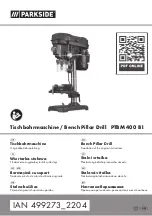
CHAPTER 4
Maintenance Procedures
S36 ROCKDRILL | PARTS & SERVICE MANUAL
January, 2021
11
Inspection of Components
1. Backhead
• Check that the water tube is of the correct
type, and the water tube seals are in good
condition. Replace if they are damaged.
• Check air stem and nut, excessive wear on the
bearing surfaces of these components will
result in the loss of air pressure to the
machine. Replace one or both if necessary.
2. Piston
• Check the striking face of the piston, it should
be flat, square to the axis and smooth. When
it is dished by up to 1 mm max. it may be
refaced square by grinding to restore a flat
surface. This grinding must be done with care
and with adequate cooling. A maximum of
2mm can be removed in these refacing
operations. Ensure that the radius on the end
of the spline is restored to prevent damage to
the chuck nut.
3. Cylinder and Front Cylinder
• The wear between the piston, cylinder and front
cylinder liner should be checked. Insert the
piston in the cylinder and pull the stem rapidly
forward from the front end, the piston should
bounce on the air cushion. If it does not, check
again with a new piston and replace the front
cylinder liner if necessary to restore this
cushion. The wear between the cylinder and
piston should not exceed 0.2 mm
(.008”).
Check the cylinder with a new piston and the
piston in a new cylinder, replace as necessary.
• If fitted, check the feed nut. This should be
replaced when the threads in the bore of the nut
are worn to half their original thickness. Make
sure the new nut is correctly assembled and
tightened. The tab washer should be correctly
fitted and locked on the nut.
4. Valve Box Assembly
• This should be cleaned and checked for burrs
on faces and bearing surfaces. Any burrs
should be carefully removed.
• When reassembled the valve must be able to
move freely inside the box and over the plug.
Wear in the valve may be checked by blocking
off the kicker port in the side of the flange on
the valve with a finger. The free movement of
the valve in the assembly should be restricted
by the air trapped beneath the valve.
5. Chuck and Bushing
• The chuck will not normally show excessive
wear, the clearance between the chuck and the
front cover should not exceed 1 mm
(.040”).
The chuck should be discarded when it has
worn 2.5 mm
(.100”) at the worst point. The
chuck insert should be discarded when it has
worn 1 mm (.040") oversize on the diameter.
• Excessive wear of the chuck insert will allow
damage to other components, particularly the
piston and striking bar. New inserts should be
pressed into place - never hammered. The
thrust pad should be replaced when the wear on
the striking bar locating face exceeds 2 mm
(.080”).
6. Rotation Drive
The air motor components should have a long
and trouble free life.
• Check the gear teeth in the rotation motor and
on the outside of the chuck gear. Any slight
burrs or surface damage should be cleaned off
to prevent further damage. Replace the gears if
the teeth are worn 50% or more.
• The needle roller bearing in the idler gear
should have good life as long as it is
adequately lubricated. Check to make sure the
idler gear runs freely and true, if not, the
bearings need replacement.
• Check the shafts to ensure minimal wear to
prevent misalignment and binding. The main
rotors and end plates may be checked for burrs
or rubbing marks and these should be cleaned
off.
• The rotors should run freely on the needle roller
bearings, if they do not, the bearings should be
checked and replaced if necessary.







































